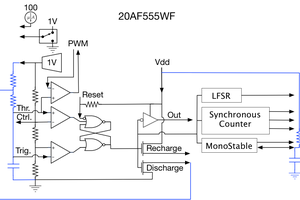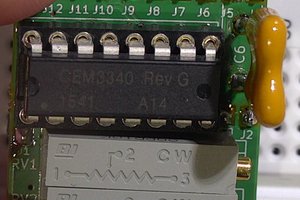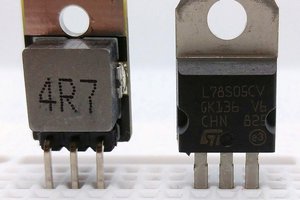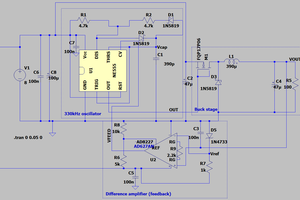For my GPSDO project I’ve opted for a Piezo 2940210 VCOCXO at 10 Mhz. There is a dearth of information on this particular module available online.
(A notation notation: I utilize “E” notation to indicate orders of magnitude; thus 1.5E-6 is in fact 0.0000015 and 7.4E3 is 7400)
Via the information available at N4IQT.com, the following specifications apply to this OCXO module:
Output Specifications
- 10 Mhz Square Wave
- 2Vp-p±10% (2.053V in this case) into 50Ω
- Load of 50W±5%
- Harmonics <-25dBc and Spurious signals <-60dBc
OCXO Stability
- Ambient Temperature Stability of <±2E-9 from -30C to 60C, Referenced at 25C
- Daily Aging Stability of <±1E-9 after the first 30 days, <±5E-10 after the first 90 days
- Yearly Aging Stability of <±1.5E-7
- 10 Year Aging Stability of <±4E-7
- Input Voltage Stability of <±5E-10 for a ±2% Voltage Change
- Short Term Stability of <±1E-10 per second
- Load Stability of <±1E-9 for a ±5% Load Change
- Phase Noise @10Hz, <-105dBc; @100Hz, <-125dBc; @1kHz, <-145dBc
Pinout
- Pin 1: Ground
- Pin 2: EFC Voltage (0-5)
- Pin 3: ??? (See Below)
- Pin 4: +24V
- Pin 5: ??? (See Below)
- Pin 6: 10MHz Output
And here is where I began to run into conflicting information:
- Heater Voltage (Pin 5) of either +15V or +24V
- What does Pin 3 output? Is it a VRef? A TTL level oven monitor?
- Is the Output (Pin 6) 2Vp-p as listed in the spec, or 4Vp-p?
- What is the EFC Sensitivity in Hertz per Volt? Is it linear?
- What is the overall draw on the 24V supply?
And so, not being one to let others do the heavy lifting, I broke out the test gear and started measuring…
Pin 5, Heater Voltage and Pin 3 Output
 So, is it +24V or +15V? I breadboarded a 7815 and a 7805 – for the
heater and EFC, respectively – and brought the +15v to Pin 5. I routed
Pin 3′s output through a 50k precision 10-turn potentiometer as a voltage divider to apply a variable voltage to the EFC pin, Pin 2.
So, is it +24V or +15V? I breadboarded a 7815 and a 7805 – for the
heater and EFC, respectively – and brought the +15v to Pin 5. I routed
Pin 3′s output through a 50k precision 10-turn potentiometer as a voltage divider to apply a variable voltage to the EFC pin, Pin 2.
 Upon
applying 24 volts, the oscillator began operation and Pin 3 showed
5.12V. So far so good; the pot dividing the pin 3 voltage was adjusted
to put 2.5V to the EFC pin and the oven was left to settle. About five
minutes in, the frequency began to drop very quickly and I discovered
that the EFC voltage had inexplicably dropped to 200mV in an instant.
Pin 3 measured <0.5V at this time. Hmmm…
Upon
applying 24 volts, the oscillator began operation and Pin 3 showed
5.12V. So far so good; the pot dividing the pin 3 voltage was adjusted
to put 2.5V to the EFC pin and the oven was left to settle. About five
minutes in, the frequency began to drop very quickly and I discovered
that the EFC voltage had inexplicably dropped to 200mV in an instant.
Pin 3 measured <0.5V at this time. Hmmm…
In an attempt to lower the time spent on this endeavor, I routed Pin 3 to the board and wired in an LED and resistor to act as an indicator. I also brought the 7805 output to the voltage divider pot and rebalanced it to 2.500V. After allowing the oven to cool slightly, I reapplied power and the Pin 3 LED immediately illuminated, only to fully extinguish less than a minute later. So. Pin 3 is in fact a TTL level oven indicator and NOT a voltage reference.
Timing the oven runtime on a coldstart, the 15V input is fully sufficient to get the oven up to temperature and keep it there indefinitely. As much as I would like to, I won’t be simplifying my power supply and running it on 24V. I do, however, wonder about that Pin 3. After the initial warmup, it does not go high again. Ever. But I know that oven has to be running intermittently to maintain the temp. Curious.
Pin 6, Output Level
Pin 6 does indeed output 2Vp-p
Supply Draw

 At 24.0V, the OCXO draws 280mA during warmup and 170mA during constant operation. Keep in mind this is with the 15V and 5V regulators taking their source from the 24V supply as well, so there’s a reasonable bit of that wasted as heat.
At 24.0V, the OCXO draws 280mA during warmup and 170mA during constant operation. Keep in mind this is with the 15V and 5V regulators taking their source from the 24V supply as well, so there’s a reasonable bit of that wasted as heat.
EFC Sensitivity: A Primer
Ah, the real meat-and-potatoes of this investigation. A critical piece of information for the disciplining of a VCXO is the sensitivity of the EFC input. The units are in Hertz per Volt (which does not need to reduce to (s^2*A)/(m^2*kg) for those of you obsessed with dimensional analysis…).
A good example to work with are the HP 10811A and 10544A models, both of which have an ‘S’ (Sensitivity) of 1E-8 per volt. What does this mean? Well, the value is referenced to the output...
Read more » PUNiSH3R
PUNiSH3R
 Adrian Freed
Adrian Freed
 Frank Buss
Frank Buss
 Stefan Wagner
Stefan Wagner
 Vedran
Vedran